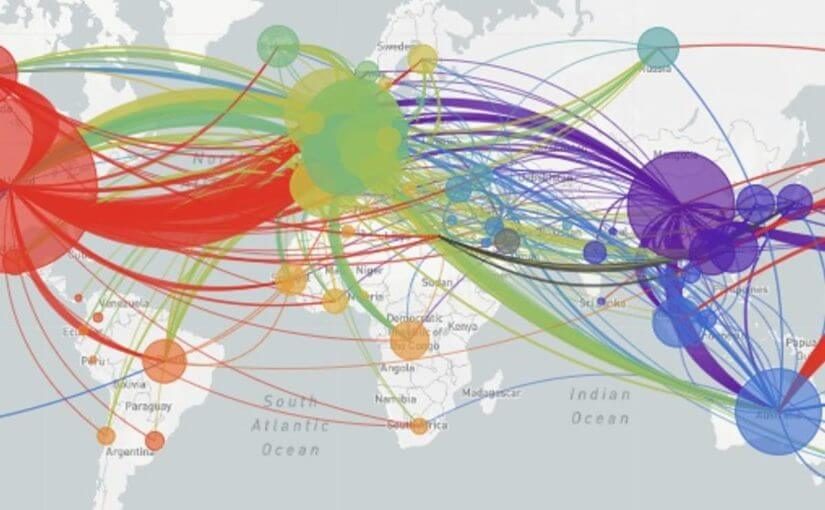A number of new concerning variants of the COVID-19 virus have begun to appear across the globe. The B.1.1.7 strain, commonly referred to as the UK strain of the virus, has now been identified in 40 other countries1 outside the UK, including Australia.
Referred to as the South African strain, the variant 501Y.V2 or B.1.351, has also appeared in hotel quarantine in New South Wales.
Early research suggests the UK and South African strains spread more easily than previous variants. The UK strain may raise the R value of the virus by at least 0.4. The R value determines the average number of people a person with COVID-19 might pass the infection to. In December 2020 it was reported that B.1.1.7 was responsible for 60% of cases of COVID-19 in London2.
Dr Rob Baird talks about genome sequencing for COVID-19 to Channel 7
Dr Robert Baird, Pathology Awareness Australia Ambassador, Director of Microbiology and Infectious Diseases Physician at the Royal Darwin Hospital said:
“The evidence is pointing towards these variants being more transmissible and that means that you only need a smaller infectious ‘dose’ of the virus for someone to become infected. It makes all the COVID infection control protocols even more vital. Settings where it is difficult to have regular cleaning, social distancing and good ventilation, for example, in the public toilets at a large event, or public transport, would become much higher risk if a variant like this is in the community.”
The B.1.1.7 and 501Y.V2 strains carry a larger than usual number of mutations3 to the genetic code. According to the Centers for Disease Control and Prevention4, the new variants have several mutations that affect the spike protein on the virus surface that attaches to human cells.
Another variant has also been reported in Japan, found in four travellers from Brazil. This variant is said to have 12 mutations and may show similarities to the B.1.1.7 and 501Y.V2 strains; research is being conducted to learn more.
The main type of test used in pathology laboratories to detect SARS-CoV-2 is the reverse-transcriptase polymerase chain reaction5 test, commonly known as PCR. This test is usually performed on a nasal and throat swab sample, and detects the virus’s genetic material in the sample.
Currently, the standard PCR tests used in Australian pathology labs can detect new variants of COVID-19, as the test targets several parts of the virus’s genetic make-up. If further mutations were to occur that significantly alter these testing targets, existing PCR tests may need to be adapted to ensure they are able to detect emerging variants effectively.
Furthermore, vaccinations against COVID-19 could be rendered less effective if mutations continue to emerge that alter the parts of the virus targeted by the vaccine. This is especially true for the 501Y.V2 strain of the virus and it is currently under investigation to ensure the vaccination program will be effective against it.
Infection control is the key to preventing the spread of the virus. If the spread is well controlled the virus will have fewer opportunities to mutate helping to ensure existing tests, vaccines and treatments remain effective.
Dr Baird said: “At the moment, we have been advised the currently approved vaccines in Western countries will be active against the new variants. Continued infection control measures to keep case numbers down will slow the rate of virus mutation. The more people there are infected with the virus, the more opportunities, it has to mutate so the key is to prevent more mutations happening, which may lead to current vaccines needing modification. Overall community vaccination rates may need to be higher for more infectious strains to combat new strains of the virus and to achieve herd immunity.”
Microbiologists use genomic sequencing techniques to identify the virus variants by their DNA or RNA. Genomic testing is different from standard PCR testing because it looks at the entire genetic make-up of the virus.
Dr Baird said:
“I explain it like an alphabet of letters in a book. The coronavirus has about 30,000 letters and when you are doing a PCR test, you’re just looking at a few hundred specific letters to give a positive or negative result. With genome sequencing you get the whole book, and you can compare that copy of the book to another copy and look for any typos (strain variants).”
Genomic testing is widely available in Australia and has been used to detect new strains of COVID-19 within patients who have arrived from overseas, and in areas where outbreaks have occurred.
There have been approximately 8,000 viral genomic sequences performed in Australia since the beginning of the pandemic. The sequences are uploaded to a database known as AUSTRAKKA6. Health care workers can use this resource to compare the genomic sequences of new cases, to track existing and emerging mutations, and any variants with characteristics that are concerning, such as B.1.1.7 and 501Y.V2.
The new variants have many potentially important mutations and one of these, N501Y, has made a significant change to the most important part of the spike protein, the receptor building domain3.
Humans have ACE receptors where the virus enters the cells using the spike protein, these receptors change shape over time as we grow up. Some scientists believe the mutations in the B.1.1.7 and 501Y.V2 variants could cause COVID-19 to spread more easily in children than before because the mutated spike protein can access juvenile ACE receptors more easily.
References:
- https://www.who.int/publications/m/item/weekly-epidemiological-update—5-january-2021
- https://www.gov.uk/government/news/phe-investigating-a-novel-variant-of-covid-19
- https://virological.org/t/preliminary-genomic-characterisation-of-an-emergent-sars-cov-2-lineage-in-the-uk-defined-by-a-novel-set-of-spike-mutations/563
- https://www.cdc.gov/coronavirus/2019-ncov/more/science-and-research/scientific-brief-emerging-variants.html
- https://www.labtestsonline.org.au/learning/index-of-conditions/covid-19/learn-more-about-covid-19
- https://www.cdgn.org.au/austrakka
IMAGE CREDIT: The Conversation

